Overview
A better place for nature and enjoyments
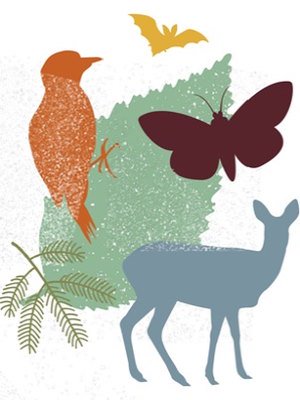
The vision for Norbury Park is that it provides for both nature and enjoyment through a balance of rich natural habitats and facilities to enable community use. The estate will be actively managed and maintained to provide a haven for nature, a place for food production, the storage and sequestration of carbon, the natural regulation of water flows, and a space for the people of Surrey to enjoy and engage with their countryside.
Our aim is to optimise the contribution that Norbury Park makes to Surrey’s Greener Future Climate Change Delivery Plan and the associated emerging Nature Recovery Strategy, whilst continuing to provide a recreational space for the people of Surrey and contributing to the health and social well-being outcomes by enabling access for a broader cross-section of the community.
We will achieve this by a gradual shift in the approach to land and woodland management and farming to focus on outcomes which reverse nature loss, enable natural flood management, and maximise the contribution of the estate’s natural capital assets to the mitigation and management of climate change.
New approaches to land management will combine more regenerative approaches to agriculture and woodland with the creation of new and enhanced ‘low or no intervention’ habitats and maximise the potential of the land to store and sequester carbon and naturally regulate water flows.
As a publicly owned greenspace, community access remains at the heart of the vision for Norbury Park. Community use of the estate will continue to be enabled with a focus on conserving and interpreting heritage, creating training and engagement opportunities linked to woodland and land management and supporting woodland and rural crafts.
The vision for Norbury Park and intended outcomes
- Conventional agriculture change to Regenerative agriculture
Outcomes: Nutritious food, increased habitat value, carbon sequestration and flood alleviation - Limited visitor facilities and activities change to New, low impact visitor facilities and activities
Outcomes: Increased use of the park for recreation by under-represented groups, improved health and wellbeing outcomes for all visitors - Active habitat and landscape management change to Nature recovery measures integrated into landscape management
Outcomes: Increased habitat value, carbon sequestration and flood alleviation - Significant flooding events change to Proactive landscape system led flood management
Outcomes: Flood events reduced in frequency and severity - Sawmill: Operational sawmill and wood products business change to Woodland Hub providing facilities for
woodland management and associated products, crafts and training
Outcomes: Increase social value through appropriate reuse of former industrial site
Recognising the inherent tension in nature recovery and public access, we do not seek to materially increase visitor numbers, acknowledging that the volume of visitors looks set to remain higher than pre-Covid levels. To achieve this, appropriately scaled and designed infrastructure will provide new facilities to support public recreational access in a manner which works alongside nature recovery.
We will address the imbalance in access to Norbury Park by certain groups through targeted interventions, enabling access for those people who do not traditionally access this type of natural recreational space and therefore do not benefit from the associated impacts on health and wellbeing.
Through the sensitive reuse of buildings and previously developed sites across Norbury Park, provision will be made for training, education, enterprise, and employment connected to the heritage and natural environment of the park, with an emphasis on woodland management and associated activities.
The aim is to establish an appropriate balance between nature recovery, recreation, and engagement – finding synergies between the land and the people who care for and enjoy it, maximising the contribution Norbury Park makes to reversing nature loss, managing climate change and providing access and engagement opportunities for the local community. The approach taken at Norbury Park will be a pilot for the new Land Management Policy being developed by Surrey County Council (SCC) to govern the management of its land assets.
In delivering this vision, we envisage that:
- Very little will change. We, like most of the community and stakeholders we have spoken to, are very content with much about Norbury Park.
- We do however want to ensure the estates’ natural capital and landscape assets are in the best possible condition and performing as well as they can in terms of carbon storage and sequestration, natural flood management, water and air quality regulation.
- We want to make Norbury Park a better place for nature as well as for people. This will require the development of new landscape-scale land management strategies, and the provision of low-impact facilities to support users of the park to access recreational, educational
and employment opportunities.
As part of Surrey’s Greener Future Programme, SCC is developing a Nature Recovery Strategy and new policies for land use. The intention is that Norbury Park will become a pilot project for how SCC can use its wider rural and countryside estate to further its environmental contribution and create opportunities for people to engage with and benefit from the natural environment.
This document sets out the component parts of this vision, informed by stakeholder, partner and community engagement which has shaped the proposals and short-term actions.
Introduction

Land is an asset that can create a range of benefits – economic, environmental and social – and SCC is in a position of owning land at a scale where these opportunities can be optimised for the benefit of those living and working on and with the land, local communities, the people of Surrey, visitors and the wider economy and environment.
Ownership of land and natural capital is a privilege. Access to land, the natural capital assets it supports, and the ecosystem services that the combination of environmental process and human intervention create, are some of the richest opportunities available to society. Land ownership carries responsibility and SCC is committed to ensuring these assets are managed in a way which delivers optimum returns balanced across a series of objectives.
Deciding how to manage land used to be relatively simple. The primary function of land since the Second World War has generally been accepted as production (food and timber) with secondary functions emerging associated with public access, recreation and public enjoyment.
The picture is now far more complex. There is a recognition that the way in which we value and manage our land needs to change. There is a more widely shared understanding of its natural capital value - the critical environmental functions it performs, the health and well-being benefits land and access to it can deliver, and the often negative impacts that traditional approaches to land management can create.
As a major landowner holding assets for the wider public good, SCC must work to optimise the benefits delivered by the land it owns. A Countryside Enhancement Transformation programme designed to identify opportunities to enhance access to and enjoyment of the countryside estate began in 2020. As part of this, a review of the contribution Norbury Park is and could make to providing recreational opportunities was undertaken.
Alongside the Countryside Enhancement Transformation programme, Surrey has responded to the Climate Emergency with an ambitious set of actions in Surrey’s Greener Future Climate Change Delivery Plan which recognises the potential of land and natural assets to contribute to climate change mitigation and seeks ways to maximise this through regenerative land management.
This balance between the role of land and natural environments in responding to climate change and public access and recreation is at the heart of the work to determine the right future management strategy for Norbury Park. What is clear is that the public good outcomes that can be delivered by Norbury Park should be nature-led, and there is an opportunity to trial new ways of land management alongside the delivery of visitor and community facilities aimed at maximising the contribution it makes to nature recovery, climate change and community health and wellbeing.
Norbury Park history
The historic Norbury Park was mentioned in the Doomsday Survey of 1086 and has been in the ownership of SCC since the early 1930s. It was purchased by the council to protect the land being broken up for housing development and now Norbury Park is a much valued resource for nature, farming, woodland and recreation.
Sitting within the Surrey Hills National Landscape - An Area of Outstanding Natural Beauty (AONB), Norbury Park’s 1,340 acres comprises mixed woodland and farmland. A significant proportion of the estate is designated as Grade 2 Registered Park and Gardens, and it hosts various environmental, landscape, and topographical features including a river, escarpment, chalk downlands, water meadows, ancient woodland and parkland. It is rich in natural capital and already generates valuable ecosystem services. The value of the site is reflected in its various designations designed to protect this important asset. Norbury Park is within the Area of Outstanding Natural Beauty (AONB), Green Belt, Site of Special Scientific Interest (SSSI) and Special Area of Conservation (SAC). A large area is also designated as Ancient Woodland.
There are three tenanted farms within the estate as well as a range of residential properties and buildings owned by SCC. There are also a number of privately owned properties, most of which were historically part of the larger estate.
Norbury Park land use zones map
The map shows Norbury Park and the locations of the Sawmill in the centre of the map, The Bothy to the east, Bocketts Farm to the north, Norbury Park Farm to the east and Swanworth Farm towards the southeast. It also shows areas of Site of Special Scientific Interest (SSSI) and ancient woodland throughout Norbury Park, and important woodland to the northeast. The River Mole winds down the east of Norbury Park, and the Surrey Hills Area of Natural Beauty (AOB) lie to the west and the south of the Park. The Fetcham, Young Street and Crab Tree Lane Car Parks are also shown on the map.
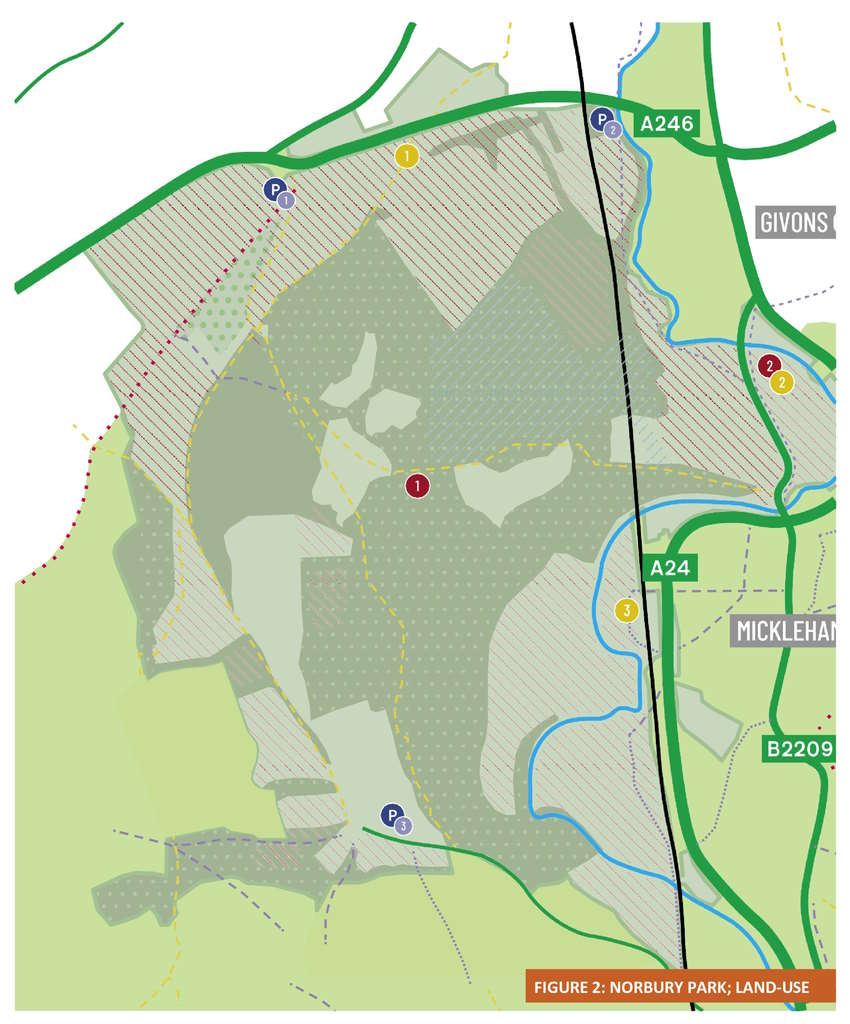
Norbury Park Grade II Registered park and garden designation
The map shows the area of park and garden at Norbury Park that are Grade II Registered. It is a large area including SSSI and ancient woodland that extends from the Sawmill in the centre of the map across to The Bothy to the east, along the River Mole and down towards Crab Tree Lane Car Park.

The topography of the estate, associated landscapes, vegetation and wildlife create an attractive and appealing setting. These features provide a range of ecosystem services including carbon sequestration and storage, regulation of water flows, clean air, biodiversity and opportunities for recreation.
Paths, trails and tracks crisscross the park allowing for walking and to lesser extent cycling and horse riding opportunities. Currently, there are no facilities for visitors beyond car parking and a ‘pop-up’ coffee outlet, however, the estate is well used by the local community for informal recreation and visitor numbers have increased significantly since the Covid pandemic.
Whilst the landscape supports a range of existing habitats and the inherent benefits of tree and vegetation cover, it has not to date been actively managed to deliver a wider set of ecosystem services. Parts of the estate require improvement, in particular, the SSSI area is assessed as being in ‘unfavourable’ condition. More widely there is potential to improve the delivery of ecosystem services through more regenerative management to optimise the condition of assets and the benefits provided, be that carbon storage, habitat provision, food production, natural flood management or recreational opportunity.
Rich in heritage and having undergone a series of changes and evolutions in terms of ownership, land cover, activities and enterprises hosted, the estate holds a high level of significance for residents and is an important part of the Surrey Hills landscape. The council’s aim is not to radically change Norbury Park, but rather to protect and enhance its habitats and natural processes and build on its heritage, natural beauty and sense of place to create more opportunities for nature and enjoyment.
The case for change
Countryside Enhancement Transformation Programme
- Enables health and well-being
- Make information exciting
- Something for everyone
- Accessible information and transport
- Celebrate and treasure
- Creating Reasons to visit
People
The benefits of time spent in nature for physical and mental health and well-being are now widely recognised with public access and recreational opportunity identified as an ecosystem service that delivers significant value to society.
SCC owns more than 2,300 hectares (6,500 acres) of countryside as well as entering into access agreements with private landowners to provide public access to a total of over 3,500 hectares (10,000 acres) of Surrey’s beautiful countryside. This is known as Surrey’s Countryside Estate. The Countryside Estate includes 17 sites for recreation including parks, commons, and woodlands. Norbury Park is identified as one of the flagship locations.
Findings of research and community engagement conducted by the council are that the most common motivator across all groups for visiting the countryside is to enhance physical and mental health.
Different groups are motivated to spend time in the countryside in different ways. Families and young people are attracted by experience and activities whilst older or disabled residents generally prefer the tranquillity they associate with spending time in the country.
The main barriers to accessing the Countryside Estate are transport, information and communication, and limitations in provision of and access to on-site facilities.
Work is underway to assess the options for the Countryside Estate to provide enhanced opportunities for recreation and quiet enjoyment. Detailed work focussed on Norbury Park has identified a range of proposals for a programme of improvement and sensitive development to support visitor use.
Nature
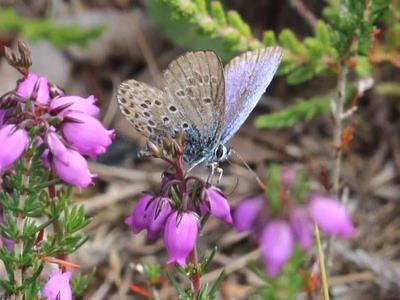
The case for tackling biodiversity loss, climate change and environmental risks to public health is pressing, with widespread recognition of the twin crises of the accelerating impact of climate change and the decline of habitats and species loss. The government has published a bold 25-Year Environment Plan and set a target to reach net-zero emissions and there are a plethora of policies, strategies and pilot schemes aimed at improving the natural environment, tackling the effects of climate change, reversing nature loss and maximising associated social and economic benefits. The question is no longer if, but when and how action will be taken to address these issues.
Climate change and nature loss are intrinsically linked and the role of our green spaces in tackling both is more important than ever before. Nature-based solutions are widely recognised as having a vital role to play in tackling climate change by increasing the carbon storage and sequestration capacity of soils, water bodies, hedges and woodlands.
By managing land in a way which optimises this capacity – such as through the restoration of forests or wetlands - nature-based solutions have the advantage of tackling climate change at the same time as supporting biodiversity and providing a wide range of benefits to people, ranging from natural flood management to health and well-being.
SCC has responded to this with a range of policy measures which set out the ambitions for the county to address environmental issues. Surrey’s Greener Future Climate Change Delivery Plan identifies four areas of focus to reflect changes that need to happen: in our communities, our public sector, our supporting infrastructure and our land.
- Greener Futures Communities: [97%] of carbon emissions
- One Net Zero Public Estate: [2% carbon emissions]
- Build Back Greener
- Grow back Greener: [0.1% carbon absorbed]
The stated aim for the Grow Back Greener theme is:
Aim: Managing woodland, green spaces and farmland to maximise our ability to absorb carbon from the atmosphere, grow food sustainably and improve habitats needed for wildlife to thrive.
Actions
Land owners and managers (including Local Authorities)
- Expected Progress by 2025 (ktCO2e): Sequester carbon through improved land management and land use change.
- Estimated Annual Carbon Reduction by 2025 (ktCO2e): 6
- What needs to happen:
- Considering local environment, biodiversity and carbon sequestration in all decisions about landscapes.
- Bringing unmanaged woodland into a maintained woodland managed for timber, planting trees, hedgerows and creating new woodland, and investing in carbon hungry landscapes such as heath
and wetlands. - Connecting people to green spaces in a sustainable way for their health, wellbeing and creativity.
- Local Authority Action to 2025:
- (67) Develop a Land Management Framework to ensure that multifunctional benefits are considered including carbon, biodiversity and flood protection.
- (68) Embed natural capital and land use opportunities designed to sequester increased carbon emissions into all appropriate infrastructure and development schemes, countryside estate management plans and land management policies.
- (69) Work with partners and academics to lobby Government to publish carbon sequestration metrics and guidance for land use change.
- (70) Bring 3,330 hectares of woodland back into management, including investigating markets for timber and wood fuel
- (71) Facilitate the planting of 600,000 trees and hedgerows in Surrey, with as many of these planted on SCC owned land as appropriate.
- (72) Develop the investment vehicles to fund carbon sequestration and natural capital schemes (through carbon offsetting and biodiversity net gain) and engaging with Surrey based businesses to develop joint opportunities.
Farming community and land owners
- Expected Progress by 2025 (ktCO2e): Embedding ecosystem services into farming and land management.
- Estimated Annual Carbon Reduction by 2025 (ktCO2e): 1
- What needs to happen: Managing farming practices to increase carbon sequestration opportunities.
- Local Authority Action to 2025:
- (73) Implement the Environmental Land Management programmes from 2024 utilising funding from the Farming in Protected Landscapes Programme (in Surrey Hills and High Weald Areas of AONB).
- (74) Manage Local Authority-owned farms based on the
principles in the Land Management Framework.
It is against this backdrop that SCC is developing a new and ambitious strategy to tackle nature loss and a new land use policy which will guide decision-making as to the most appropriate land use and management strategies to optimise the benefits different types of land can offer. Norbury Park will act as a pilot for evidence-based decision-making regarding land management strategies.
The opportunity
Norbury Park represents a significant opportunity to deliver against Surrey’s Greener Future ambitions. It is a hugely valuable natural capital asset with enormous potential to help combat climate change through the sequestration and storage of carbon, to provide a protected space for nature, and to demonstrate and inform the people of Surrey about the benefits that natural capital
can deliver.
The current land use and established management approach have focussed on low-impact recreation, conventional agriculture and targeted conservation activity and there is a recognition that a continuation of this approach will not optimise the public good that can be delivered from this important asset.
This contribution can be significantly enhanced through managing Norbury Park in a way which prioritises nature recovery and natural processes. This requires an approach which looks beyond the existing accepted norm for farming, conservation, woodland management and public access and instead considers Norbury Park as a natural capital asset, managed holistically as a single entity within a wider ecological network to deliver optimum ecosystem services.
Decisions over land use, changes in land management approach and investment in visitor experience will be guided by the following principles:
- A balanced approach where no one land use or user group takes overall priority and decisions are based on quantitative improvements to natural capital accounts.
- A hierarchy of land use will guide decisions about what happens and where to:
- Ensure those areas of the highest value for nature and conservation are managed to optimise nature recovery;
- Identify where there are opportunities to enable natural process-led nature recovery; and
- Enable access and enhancement of the visitor experience through low-impact infrastructure and activities and by broadening opportunities for people of all kinds and backgrounds to experience and enjoy Norbury Park.
A balance will be sought between the three core functions of Norbury Park
Access
- Respond to demand for access to countryside
- Create appropriate infrastructure to enable and manage
- Create opportunities for those not traditionally accessing green spaces to improve equality of the
benefits provided.
Landscape
- Protect and conserve landscape character, considering the historical evolution of Norbury Parkland landscape and its different zones and land uses
- Enable ongoing use of land for food production
- Increase capacity of land to deliver enhanced carbon storage and flood management functions as well as opportunities for community involvement and .benefit.
Nature
- Protect, enhance and create habitats
- Restore natural processes including low/no input areas to maximise regeneration of land
- Continue to balance public access areas with lowest ecological value and least potential for enhancement.
Delivering the vision
The vision for Norbury Park is for it to provide for both nature and enjoyment through a balance of rich natural habitats and facilities to support community use. The land, buildings and activities that take place within it will offer enhanced opportunities for the enjoyment and connectivity to nature by the local community, but the priority focus will be on maximising the provision of optimised habitats for nature and managing the effects of climate change.
The strategy for Norbury Park is nature-led – transitioning to regenerative land management, focussed initially on areas of greatest opportunity for enhancement, alongside the creation of new ‘light touch’ infrastructure for visitors and facilities to support community engagement and education.
Longer-term, the ambition is to move towards a nature-led approach to managing the whole of Norbury Park to maximise the contribution the estate makes to climate change and biodiversity alongside public recreation.
The objectives for Norbury Park are that it:
- Takes an actively regenerative approach to land management that balances the optimisation of carbon storage and sequestration, nature recovery and natural flood management with the production of food and active woodland management;
- Hosts viable farm enterprises and evolves the role of agriculture in sustainable land-use systems;
- Provides appropriate facilities and infrastructure to support visitors and groups engaged in activities to promote learning, health wellbeing, rehabilitation, and recreation;
- Contributes to people’s understanding of the role and value of land and nature in tackling climate change and the provision of habitats; and
- Creates opportunities for education, enterprise, and engagement for the community with nature, with provision for marginalised groups.
SCC has looked at the natural and built assets of the estate to determine how these can best be leveraged. A range of projects have been identified that will contribute to these objectives. Some of these projects have been delivered or are in progress, while others are undergoing further research and analysis to plan for their delivery in the coming months and years.
Places and projects
Landscape: Woodlands, grassland, heathland, farmland and the River Mole
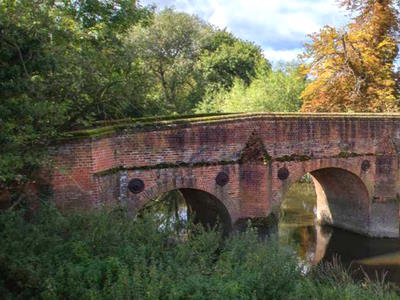
Norbury Park is a green space currently hosting wildlife, a range of vegetation types, waterways, three farm enterprises and parkland. Despite the apparent abundance of the natural asset base, Norbury Park is not currently managed to optimise nature or mitigate climate change. Parts of the land are ecologically depleted (with some of the designated SSSI in unfavourable or recovering condition), there is widespread ash dieback, evidence of significant veteran tree loss and there have been material flooding events affecting farmland and the A24.
SCC intends to mitigate these issues by producing a detailed ten-year land management plan which supports a balance between nature, carbon, access, natural flood risk management and other ecosystem services to reflect the new pressures on land management.
This will be based upon a long-term process-led land management strategy that optimises the environmental contribution that Norbury Park makes. However, with various farm tenancies, ancient woodland and open access across the site, there are a unique set of challenges to achieving a process-led system.
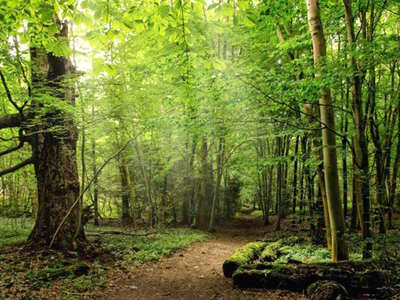
Farming has been an important part of Norbury Park for centuries. There are three farms in Norbury Park which play an important role in managing the landscape and the habitats it supports. Any proposals for the future management of the estate will consider the role of productive farming and food production for local consumption as part of a sustainable land use strategy.
In order to help imagine the most creative and exciting opportunities for biodiversity conservation, it will be necessary in time to work at an estate-wide scale. There is potential for a wood pasture, wetland and floodplain meadow system integrated with well-managed woodland and chalk downland. Such an approach represents an exciting long-term opportunity to regenerate Norbury Park and repair ecological depletion.
This long-term vision needs to be underpinned by detailed investigations and plans as to how this would be achieved. SCC is proposing a staged approach to ensure balance with the access, the recreational objectives of the council and the implications in terms of farm business and land management.
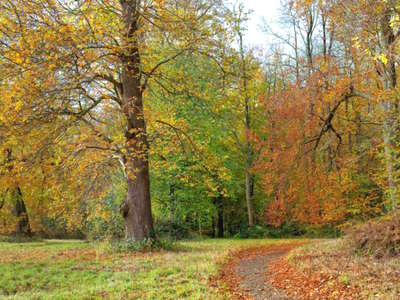
Given the climate and nature loss drivers influencing UK policymakers and public opinion, agriculture in the United Kingdom faces the biggest changes in a generation as the Common Agricultural Policy payments are phased out and a new funding regime is introduced. Based on the principles of ‘public money for public good’, the new Environmental Land Management Schemes are set to reward farmers for producing public goods on their land.
Farming practices on the estate are conventional and have responded to the previous payment regime, with a primary focus on food production. Parts of the estate present challenges to the farmers – with flooding, soil quality and infrastructure limitations impacting farm performance. The farms have not, like almost all farms in the UK to date, been managed in line with the principles of regenerative land management.
The council plans to work with its farm tenants and contractors to achieve an incremental shift towards an approach that will actively manage the natural capital of Norbury Park for the benefit of nature alongside food production and to deliver the best public value from the ecosystem services it can provide. These include:
- The production of food, timber and fibre.
- The creation and maintenance of habitat to support and enhance biodiversity.
- The storage and sequestration of carbon.
- The ongoing improvement of soil health.
- The regulation of water flows delivering natural flood management.
- The regulation of water quality via reduced nutrient leaching and soil erosion.
- The regulation of air quality.
Work is underway to determine an optimum land management strategy for the park. It is likely this
will include:
- Active management of the woodlands including coppicing, the removal of trees that pose a threat to safe public access, those suffering from a substantive disease (such as ash dieback) and areas of natural regeneration where this prejudices the natural chalk downland alongside areas of re-planting.
- Managed access in some areas of the park to benefit nature and to ensure public safety.
- Interventions to increase natural solutions for flood prevention and mitigation.
- Interventions in partnership with the Council’s farm tenants to enable a shift to more
regenerative practices focused on nature recovery, flood management and lower input
farming techniques.
Swanworth Farm
Swanworth Farm covers in the region of 153 acres and comprises eleven fields. Nine of these fields are pasture, with the remainder arable. In the northeast region of the site sits Swanworth Farmstead, comprising a farmhouse with six outbuildings, including a large barn.
The farm has been managed according to conventional agricultural practice with a focus on production and maximising stocking levels. However, a large proportion of the farm is designated as Flood Zone 3 and due to flooding, soil type and ground conditions, the arable land is not currently in productive use. The farmstead is in poor structural condition and the farm is not financially viable long term in its current form.
The farm tenant is committed to the land and the local area having lived and farmed here all his life. Working with SCC and its advisors, a strategy for a transition to a more regenerative and sustainable way of farming at Swanworth Farm is emerging.
The initial proposals under consideration for Swanworth Farm are:
- The creation of a new wood pasture.
- A commitment to soil improvement.
- The re-wetting of some areas.
- A reduction in livestock numbers whilst extending managed grazing to uphill areas to help maintain chalk grassland and heath.
- A reduction in the use of artificial fertilisers and chemicals.
- Regeneration and improvement of hay meadows.
- A gradual naturalisation of grazing land on the flood plain of the River Mole.
Swanworth Farm map
Map showing Swanworth Farmstead with Norbury Park to the northwest and the River Mole between Swanworth Farm and Lodge Farm. Mickleham is shown to the east an West Humble to the South.
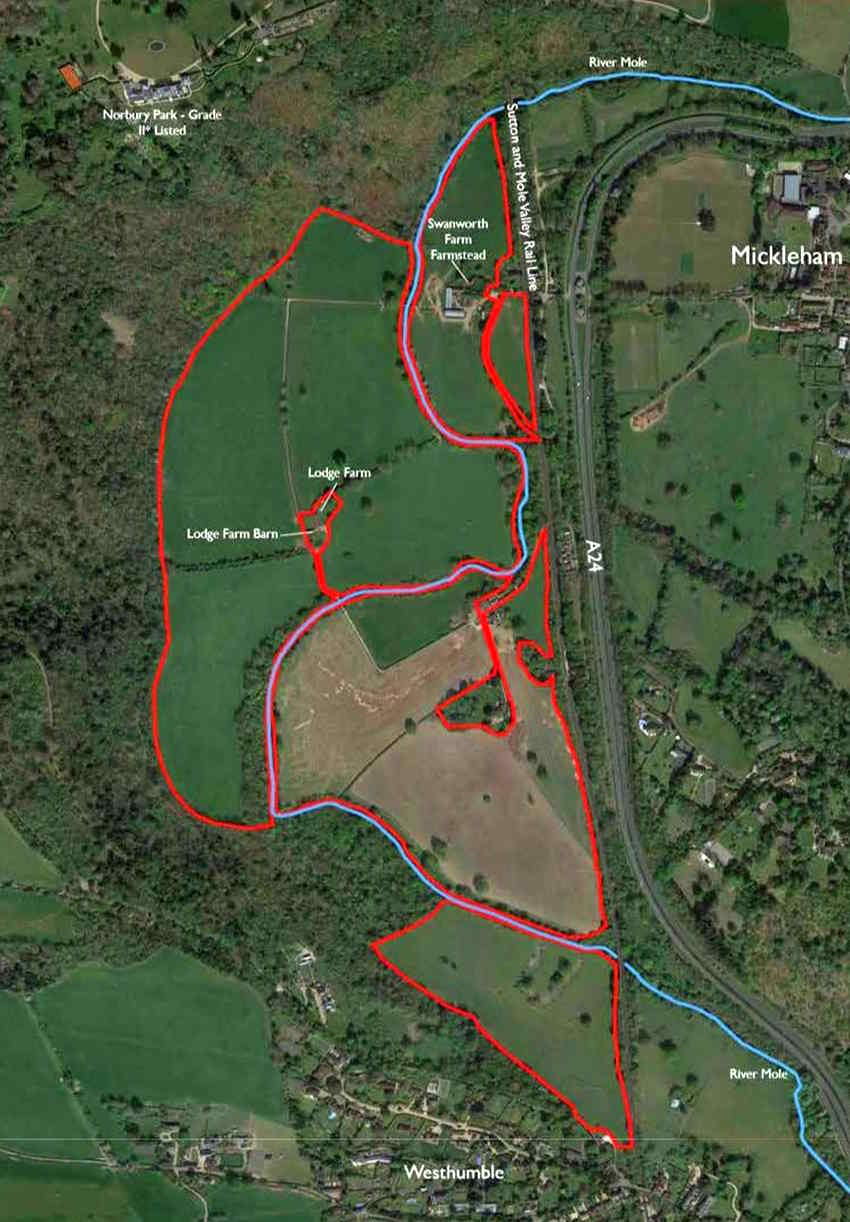
Recreation, enterprise, education and engagement
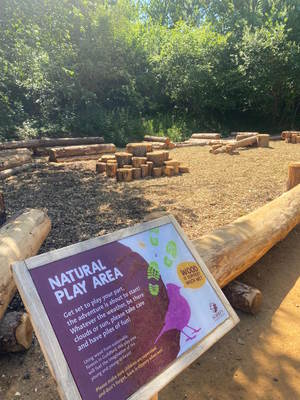
The council plans to make use of various sites across the park to support the management of Norbury Park and to provide improved visitor facilities and experience.
Live Projects
Young Street Car Park
Improvements to the car park and visitor amenities include:
- Access improvements – resurfacing work on the car park and path and restoration of steps to the river.
- Levelling and seeding to create a picnic area.
- Installation of natural play equipment.
- Hedgerow enhancement and creation including 60 metres of new hedgerow laid and native shrub species planted.
Status: Operational
Nature and Heritage Trails
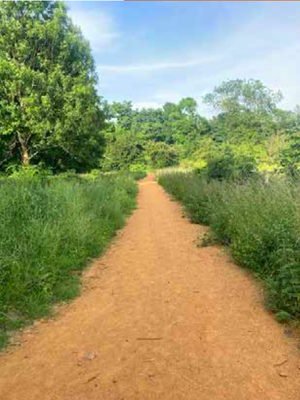
A series of trails are under consideration to add interest and experience value for visitors, whilst directing users of the park to areas which will be selected based on their suitability for this type of use. A review is underway of all paths and trails in Norbury Park – current and proposed – and this consultation will inform final decisions on which new trails may be created and where.
SCC will work with the Norbury Park Community Forum, Natural England and other stakeholders to determine appropriate routes
and types of trails and installations.
Status: New trails under consideration and subject to consultation later in 2022.
The Bothy
In use as a management depot for SCC Countryside Services, their contractors and support teams to be used for storage and as a base for management operations. Future development will be light touch and for operational improvements. This site may also be used to service occasional events.
Status: Operational
The Sawmill
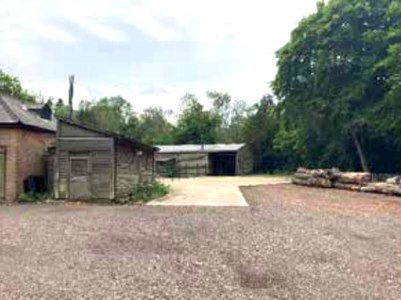
Workshop facilities for occasional use as a training facility for the community and special interest groups. Programme to undertake the necessary works to make the site safe and accessible.
Provision of a site for a pop-up food and beverage vendor on a licensee basis, operating on average four days a week will continue.
Works on-site to date and planned include:
Completed works:
- Site-wide groundworks
- New fencing erected
- Underground mains water supply
- Roof inspection and gutter clearance
- All machinery serviced and catalogued
- Roller doors serviced and repaired
- CCTV, fire alarm and intruder alarm systems installed
- Additional external lighting installed
- Staff area with kitchen facilities installed
- Phone line installed
Planned works:
- Portable accessible toilet unit to be installed (not for public use)
- Industrial cleaning, testing, servicing and risk assessments
- PAT testing
- Wi-Fi connection
Status: Budget secured. Programme of works in progress.
Swanworth Farm
Continuation of farming enterprise with seasonal wild camping offer under 28-day permitted development rights.
Forward planning for farm operations and land management aligned to a wider strategy.
Status: Review of future farm operations and land management underway.
Phoenice Fields
Use as a wedding venue under 28-day permitted development rights. Traffic and wildlife impact are under regular review.
Status: Operational. Ongoing review of impact.
Conclusion and next steps
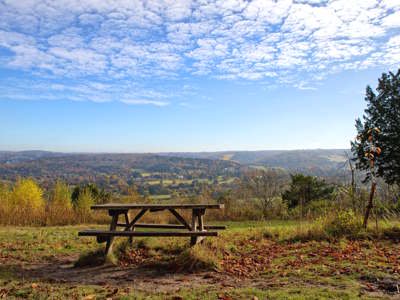
Norbury Park presents an exciting opportunity to combine nature recovery, regenerative farming, and land and woodland management with engagement and recreational opportunities for the people of Surrey.
SCC will continue to engage with a range of stakeholders, community representatives and the public. Change will be delivered in a way which brings those who manage and enjoy the land on the journey, working together to develop a long term strategy for the estate. This will see Norbury Park become a major contributor to Surrey’s environmental improvements, help to deliver material social gains whilst enabling the community to continue to enjoy informal access and quiet recreation.
Photo credits
- Jon Hawkins and Surrey Wildlife Trust: Introduction, Places and projects (all 3 photos), Nature and heritage trails, Sawmill, Conclusion and next steps.
- Surrey County Council: Natural play area
Files available to download
-
Norbury Park vision document (PDF)
This document sets out the vision for Norbury Park regarding both nature and public enjoyment, informed by stakeholder and community engagement.

